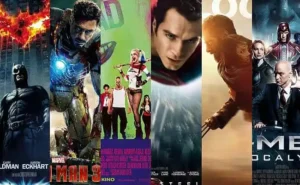Table of Contents
Historical films derive their fascination from their connection to reality. Even though filmmakers take artistic liberties throughout their work, the genre’s works are always based on true events or at least set in a historically authentic setting.
Adapting past works into the cinematic world of the present simultaneously offers viewers the chance to immerse themselves in days gone by vividly. In this way, the sober reports from our history books are transformed into a tangible experience, which only the medium of film can achieve. Today we present to you the 35 best historical movies that cinema has given us to date. Enjoy our selection!
1st place: Schindler’s List (1993)
During the Nazi era, our nation’s darkest period, courageous heroes who stood up against fascism and misanthropy were few and far between. But there was. German entrepreneur Oskar Schindler, for example, was among those personalities who put themselves at immense risk to save the lives of others.
Steven Spielberg’s 1993 work deals with the very acts of Schindler (Liam Neeson), who employed over 1,000 Jews from the Warsaw Ghetto in his factories, saving them from certain death. The film’s greatest artifice lies in its staging. The creators decided to shoot the flick almost entirely in black and white.
Through this stunt, “Schindler’s List” spreads an oppressive sense of authenticity because, after all, those clips we know of that actually come from the Nazi era are generally colorless as well. Special praise is due to Ralph Fiennes’ performance. The British actors slipped Anno Dato into the role of the SS officer Amon Göth.
A human monster who massacres the prisoners under his command in a bestial way. The film, which won seven Oscars, is considered a timeless masterpiece due to its oppressive intensity and is still frequently shown in German schools.
2nd place: 12 Years A Slave (2013)
“12 Years A Slave” deals with the true story of Solomon Northrup, an African-American who, during the 19. The writer lives as a free man in the enlightened north of the USA at the end of the nineteenth century. However, a treacherous ruse soon landed Solomon on a slave ship bound for the southern states. From then on, the once proud man is robbed of everything he has. Treated like cattle and separated from his family, the protagonist begins a twelve-year episode of tyranny.
Starring Chiwetel Ejiofor, “12 Years A Slave” paints a chilling picture of the human soul. In the process, the viewer is shown through impressive, unsparing scenes that generally valid moral concepts are often nothing more than illusions that disappear completely when a certain national border is crossed.
3rd place: Sophie’s Choice (1982)
The horror that the victims of National Socialism had to suffer often only becomes comprehensible when we look at individual fates. We are presented with such an individual case in “Sophie’s Choice” from 1982.
The historical drama sets its frame story in New York shortly after the end of World War II. Stingo (Peter MacNicol), a writer who has moved in, soon finds himself under the spell of his enigmatic neighbor Sophie (Meryl Streep). As the film progresses, it becomes clear that Sophie, a Jewish woman, was once imprisoned in Auschwitz.
Meryl Streep later received the Oscar for her performance in the category “best leading actress.” The historical film hits its viewers right in the heart due to its touching emotionality and does not leave a dry eye in the process.
4th place: Braveheart (1995)
“Braveheart” presents us with Mel Gibson as a stalwart leader who defends his fellow Scots in the 13. It wants to free the twentieth century from the bondage of the British crown.
The film, which won five Oscars, is not one of the most historically accurate works. Still, the film has a particularly high visual value, which gains substance through impressive battle scenes and exuberant pathos.
The 1995 film, which Gibson not only starred in but also directed and produced, is now an absolute cult film and should not be missing from any film collection.
5th place: Saving Private Ryan (1998)
While “Saving Private Ryan” is not the first war film to make its way into international movie theaters, the flick accomplishes something many of its genre peers could not.
The film by Steven Spielberg comes with a frighteningly brutal realism, which already comes into its own in the opening scene, which deals with the landing of the Allied troops in Normandy. The historical film deliberately wants to disturb its viewers at certain points in order to paint as authentic a picture as possible of the fighting at that time.
Thus we see desperate soldiers who have had their limbs torn off or seasoned men who call for their mothers in the face of death. Through this drastic portrayal, we viewers first learn what war really means.
6th place: Gladiator (2000)
If there is a film that deserves the designation “epic,” it is undoubtedly “Gladiator” from 2000. Everything about this work seems huge, imposing, and impressive.
As befits a historical adaptation, “Gladiator” does not skimp on pompous backdrops and the presentation of many historical personalities. However, the presented facts should not be taken too closely; after all, the filmmakers did not miss the opportunity to point out at the end that “Gladiator” is a fictional work of fiction and makes no claim to historical authenticity.
7th place: Ben-Hur (1959)
If you want to see “Ben-Hur,” you’ll need a lot of patience. After all, the classic from the 50s comes with an immense running time of 222 minutes. Still, we can say in all conscience that this is a lot of time well spent.
The monumental film in an ancient setting is considered a genre milestone. Even today, we are amazed by the incredibly large and equally detailed sets, which were painstakingly handcrafted. The story about betrayal and revenge is still convincing more than 60 years after its release.
8th place: Lincoln (2012)
“Lincoln” sets shortly after the beginning of the second term of the 16th president. Presidents of the United States too. So, the year is 1864, as the American Civil War is slowly but surely coming to an end, and the leader of the states must somehow try to mold the fractured bunch into a new entity. However, special attention is paid to the abolition of slavery. This a very respectable request of the president, which does not only meet with supporters in the House of Representatives.
Even if we as viewers already know what end the debates about obsolete laws and contempt for humanity will take, director Steven Spielberg and especially protagonist Daniel Day-Lewis managed to create an atmosphere of tension and drama that projects itself against a better judgment from the screen directly onto the sofa.
9th place: Black Hawk Down (2001)
Many war films move their plot to the time of World War II or the battlefields of Vietnam. Director Ridley Scott, however, decided in the course of “Black Hawk Down” to choose a setting not overly illuminated in pop culture media. The film takes us to 1993, directly into the turmoil of the civil war in Somalia. To help the people of Mogadishu fight warlord Mohamed Farrah Aidid, the U.S. sends in some of its best elite soldiers. But the mission is to turn out very quickly as crueler than first thought.
“Black Hawk Down” works so well because it is one of the few American war films that does not drown in heroic patriotism. Instead of national glorification, we are presented with an intense and delightfully nuanced account of what happened.
Rank 10: Titanic (1997)
Even if opinions differ about “Titanic,” the 1997 blockbuster is undisputed. In addition to the love story of Rose (Kate Winslet) and Jack (Leonardo DiCaprio), the film introduces us to some historical figures who booked a ticket on the luxury liner Titanic in 1912. Before the flick culminates in its big iceberg disaster, we’re served up detailed backdrops that range from the posh first-class suites to the shanties of the common rabble.
With a predictable but charming romance, Titanic advanced to become one of the most successful motion pictures of all time and a true classic.
Rank 11: 300 (2006)
Stylish, gritty, bloody. There are many attributes with which one can title “300” by Zack Snyder. The film is loosely based on the ancient battle of Thermopylae, where an alliance of a few Greeks once opposed the invading Persians. In the film, this resistance is essentially limited to 300 Spartans facing a sheer superiority of enemies under the rule of the self-proclaimed god-king Xerxes.
The film bursts with pathos and shines with its skillfully staged battle scenes. One slow-motion effect follows the next while we watch open-mouthed as severed limbs whirl through the air as if they were confetti.
Rank 12: Joyeux Noel (merry Christmas) (2005)
Contrary to the first assumption, in “Merry Christmas” from 2005, we don’t get to see merry Christmas elves, but two hostile nations that fight each other to the death. The protagonists find themselves in France in 1914 at the end of the first year of the war. The battle between German and French troops is deadlocked; the trench warfare claims countless lives but does not yield a single meter of land gain for either party.
As Christmas Eve approaches, the soldiers of both sides begin to rediscover their humanity. What follows are scenes that seem to be from another world within the war scenario. The temporary fraternization of mortal enemies goes deep under the skin and gives us a little light in an otherwise hopeless world.
Rank 13: The Patriot (2000)
If you can’t really relate to American hurrah patriotism, you should probably stay away from “The Patriot.” However, those who correctly categorize the epic pathos and understand the 2000 machination as an art object will lightheartedly enjoy the performance of protagonist Mel Gibson, who fights for the freedom of nation and family at the time of the American War of Independence. The film’s visually stunning production leaves a lasting impression.
14th place: Gangs of New York (2002)
Gang crime is by no means a phenomenon of modern times. As we learn in “Gangs of New York,” various urban factions were already fighting each other during the mid-19th century. Century. The 2002 work tastes thorough of soot, blood, and coarse bricks. And this with frightening topicality; after all, the “Natives” fight their opponents because of their foreign, Irish origin.
Its story is told by “Gangs of New York” ruthlessly. The drastic depictions of violence are certainly not to everyone’s taste, but they make the characters seem completely authentic in their rawness. Although the film by Martin Scorsese was nominated for 10 “Oscars,” it was to miss an award.
Rank 15: Kingdom of Heaven (2005)
The era of the Crusades was one of suffering and brutality. Actually, the blacksmith Balian (Orlando Bloom) didn’t really have much to do with warfare. However, after the protagonist loses his father, he travels to the Holy Land with knight Godfrey (Liam Neeson). He quickly gets caught up in the turmoil of the battles between the Crusaders and the Saracens. Under the guise of divine will, diabolical fights break out again and again, which in their monumental presentation, both frighten and fascinate us.
“Kingdom of Heaven” is one of those historical dramas that scores points for its neutrality. Neither of the two opposing sides is glorified or put down here.
Rank 16: Inglourious Basterds (2009)
As we are used to from Quentin Tarantino, “Inglourious Basterds” also exaggerates unrestrainedly at many points. In this case, historical realism is clearly superseded by the style factor. In addition to the cult director’s typically excellent dialogues, there is again no shortage of red sauce on the screen.
The superbly cast, including Brad Pitt, includes many German actors for the sake of authenticity. After all, the film is set in Nazi-occupied France during the Second World War.
Particularly noteworthy is the performance of Christoph Waltz. With his embodiment of SS-Standartenführer Hans Landa, the Austrian managed to create a creepy villain and, at the same time, play himself into the hearts of a broad international audience. This fact earned the actor the respect of the experts and an Oscar in the category “Best Supporting Actor.”
17th place: The King’s Speech (2010)
Are monarchs the epitome of power and sanctity? Not in the case of Prince Albert, a member of the British royal family and the rightful heir to the throne of King George V. The nobleman has had a severe speech disorder since his childhood. Instead of a rousing speech, the subjects hear an acoustic fiasco on the radio.
The stuttering causes Albert great private problems and makes the king-to-be a public laughingstock. To eradicate his speech problems, the prince decides to start a special therapy with Lionel Logue. What follows is not only the beginning of an unusual friendship but also proof that everyone is vulnerable, regardless of their social position.
The emotionally moving film by Tom Hooper won big at the 2011 Academy Awards. In total, the film won four trophies, including the coveted award in the section “best film.”
18th place: Das Boot (1981)
In order to cut off supplies to the hated British enemies by sea, German U-boats repeatedly carried out attacks on enemy cargo ships in 1941. One of these submarines is named U-96 and also serves as a backdrop for the following, depending on the version, 208-282 minutes of the film.
The production, which was enormously expensive for its time but equally lavish, manages to create a frightening feeling of claustrophobia in its viewers. Even though we are sitting at home in the cozy living room, at any moment, we have the feeling that the ceiling could collapse and the waters of the merciless ocean will swallow us.
While many German films are nowadays hastily labeled as garbage, Wolfgang Petersen created a cinematic masterpiece in 1981 that still enjoys high international acclaim.
Rank 19: Troy (2004)
In 2004 Wolfgang Petersen gave the cinema world a monumental epic that takes its plot back to ancient Greece. In the leading roles, the spectators see Brad Pitt, Eric Bana, and Diane Kruger. The latter is carried off to the hostile Troy in the skin of the Spartan queen Helen.
This is how the fire of war is ignited, which in the form of visually stunning mass choreography, elaborate sets, and stylish costumes, ensures that viewers are glued to their screens. While the film came away empty-handed at the 2005 Oscars, Brad Pitt won the Teen Choice Award for Best Action Star.
20th place: Apollo 13 (1995)
The moon mission, which was launched in April 1970 and named “Apollo 13”, ended in a real disaster. From the start, the crew around protagonist Tom Hanks has to deal with technical and human problems repeatedly. Finally, the situation comes to a dramatic head: after the oxygen tank of the spaceship explodes, the crew runs out of air to breathe. This starts a daring rescue operation that tests the nerves of actors and viewers.







